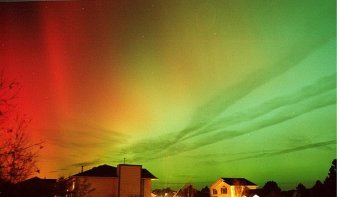The Aurora Borealis (commonly referred to as the Northern Lights) are the result of interactions between the Sun and Earth's outer atmosphere. The Aurora Australis is the southern hemisphere counterpart to the Aurora Borealis.
What Causes the Aurora? The Sun emits electrically-charged particles called ions, which correspondingly move away from the Sun in a stream of plasma (ionized gas) known as the solar wind. As the plasma comes in contact with the Earth's magnetic field, the ions will be agitated into moving around the Earth. Some of the ions become trapped and will consequently interact with the Earth's ionosphere (an average of 60-80 miles above the surface), causing the ions to glow. This is the same principal as how a neon sign lights up. As electrons pass through the neon tubing, they glow, thus producing the light in a neon sign.
The Aurora are constantly changing and moving in streams of light or curtains, because the process of how the Sun's ionized gas interacts with the Earth's magnetic field is very dynamic. Although harmless to life on Earth, the Aurora can cause power disruptions in satellite communications and in radio/TV broadcasts.
Aurora Displays: The northern latitudes (or southern latitudes in the southern hemisphere) see the greatest occurrence of the Aurora. In the northern hemisphere, there is a 50% or greater chance of seeing Aurora roughly between the latitudes of 55 to 80 degrees north. This means in general that in these latitudes, the Aurora should occur on at least half of the nights throughout the year. However, this also varies. Aurora displays usually increase during times of the solar maximum. They also usually show a greater frequency during the winter months, where the nights are longer and the skies generally void of haze. Although most common in the northern latitudes, the Aurora have been occasionally seen south of 35 degrees north latitude which encompasses the far southern United States. Displays this far south can occur when a large coronal mass ejection from the Sun creates a huge geomagnetic storm in the Earth's outer atmosphere. This occurred on the night of November 5th and 6th, 2001 where amazing Aurora displays were seen as far south as Texas, Arizona and San Diego, CA
 An NWS employee formerly in Rapid City SD, took this spectacular picture of an Aurora Borealis display on November 5th, 2001. The Aurora this night was seen over many parts of the Northern Hemisphere north of the tropics, courtesy of an unusually large geomagnetic storm.
An NWS employee formerly in Rapid City SD, took this spectacular picture of an Aurora Borealis display on November 5th, 2001. The Aurora this night was seen over many parts of the Northern Hemisphere north of the tropics, courtesy of an unusually large geomagnetic storm.